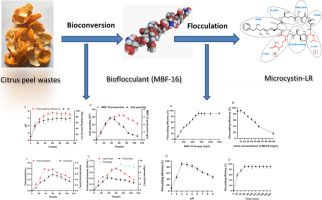当前位置:
X-MOL 学术
›
Sci. Total Environ.
›
论文详情
Our official English website, www.x-mol.net, welcomes your feedback! (Note: you will need to create a separate account there.)
Bioconversion of citrus peel wastes into bioflocculants and their application in the removal of microcystins.
Science of the Total Environment ( IF 9.8 ) Pub Date : 2020-01-23 , DOI: 10.1016/j.scitotenv.2020.136885 Xiaoli Qi 1 , Yongliang Zheng 2 , Ningjia Tang 3 , Jiangang Zhou 4 , Su Sun 5
Science of the Total Environment ( IF 9.8 ) Pub Date : 2020-01-23 , DOI: 10.1016/j.scitotenv.2020.136885 Xiaoli Qi 1 , Yongliang Zheng 2 , Ningjia Tang 3 , Jiangang Zhou 4 , Su Sun 5
Affiliation

|
In this study, the mechanism for converting citrus peel wastes (CPW) into bioflocculants using Alcaligenes faecalis subsp. phenolicus ZY-16 was analysed. The results demonstrated that the ZY-16 strain could produce various lignocellulolytic enzymes, containing cellulase, hemicellulase, pectinase, protease, and ligninase, enhancing the hydrolysis of citrus peel wastes. Molecular distillation removes antimicrobial limonene, which could inhibit bioflocculant production. The optimal fermentation conditions with the highest bioflocculant yield (3.49 g/L) were 38.79 g/L of CPW, 35.54 °C, and pH 4.48. Furthermore, the bioflocculant was used to eliminate microcystins for the first time, and the highest removal efficiency (90.05%) was achieved at a pH of 3.0, after 800 mg/L of bioflocculant was added into the microcystins solution (10 mg/L) for 60 min. Therefore, this paper demonstrated that CPW could be a cost-effective feedstock for the production of bioflocculants, which have potential application in microcystin removal.
中文翻译:

柑桔皮废料的生物转化为生物絮凝剂及其在去除微囊藻毒素中的应用。
在这项研究中,使用粪便产碱杆菌亚种将柑桔皮废物(CPW)转化为生物絮凝剂的机理。分析了酚ZY-16。结果表明,ZY-16菌株可以产生各种木质纤维素分解酶,包括纤维素酶,半纤维素酶,果胶酶,蛋白酶和木质素酶,从而增强了柑桔皮废物的水解。分子蒸馏去除了抗菌柠檬烯,它可以抑制生物絮凝剂的产生。具有最高生物絮凝剂产量(3.49 g / L)的最佳发酵条件是CPW为38.79 g / L,35.54°C和pH为4.48。此外,将生物絮凝剂首次用于消除微囊藻毒素,在将800 mg / L的生物絮凝剂添加到微囊藻毒素溶液(10 mg / L)中后,在pH为3.0时达到了最高去除效率(90.05%) 60分钟
更新日期:2020-01-23
中文翻译:

柑桔皮废料的生物转化为生物絮凝剂及其在去除微囊藻毒素中的应用。
在这项研究中,使用粪便产碱杆菌亚种将柑桔皮废物(CPW)转化为生物絮凝剂的机理。分析了酚ZY-16。结果表明,ZY-16菌株可以产生各种木质纤维素分解酶,包括纤维素酶,半纤维素酶,果胶酶,蛋白酶和木质素酶,从而增强了柑桔皮废物的水解。分子蒸馏去除了抗菌柠檬烯,它可以抑制生物絮凝剂的产生。具有最高生物絮凝剂产量(3.49 g / L)的最佳发酵条件是CPW为38.79 g / L,35.54°C和pH为4.48。此外,将生物絮凝剂首次用于消除微囊藻毒素,在将800 mg / L的生物絮凝剂添加到微囊藻毒素溶液(10 mg / L)中后,在pH为3.0时达到了最高去除效率(90.05%) 60分钟

























 京公网安备 11010802027423号
京公网安备 11010802027423号